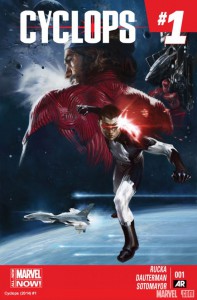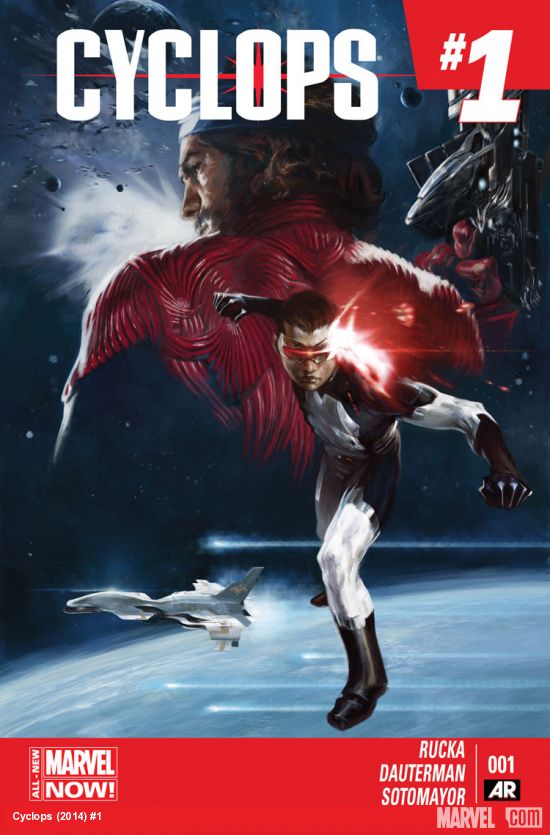
Art by Russell Dauterman
Colors by Chris Sotomayor
Letters by VC’s Joe Caramanga
Standard Cover by Alexander Lozano
Published by Marvel Comics
Despite being created in 1963 and having been a stalwart member of the X-Men for most of the intervening fifty plus years, this is the first time Cyclops (aka Scott Summers) has ever received his own ongoing series. Much of what defines the character – his taciturn nature, his strong leadership abilities, his devotion to Professor Xavier’s dream of peaceful co-existence between man and mutant – works best (or at all) when placed in a group setting, able to be compared and contrasted with the other X-Men. This series aims to sidestep that issue by taking advantage of the character’s current unique status quo: there are actually two Cyclops running around the Marvel Universe, the “real”, present day one, and a teenaged version, plucked from the past and deposited in his future as part of Brian Michael Bendis’ All New X-Men.
It is that iteration of the character writer Greg Rucka casts in this series, and while “time traveling younger version of an established character” is a relatively dense concept around which to build a series, especially for new readers, the events of the recent “Trial of Jean Grey” storyline allow Rucka to cast this book far afield from the other Cyclops. Having recently learned his father, the space pirate Corsair, is alive, young Scott left the X-Men to join Corsair’s Starjammers and become better acquainted with his father. As a result, this issue reads more like an issue of Star Wars than X-Men, complete with aliens and swordplay and dogfights between spaceships, and that’s not a bad thing. It gives Rucka a unique setting, relative to the other X-Books, to work in, a setting rife with storytelling possibilities yet one in which the character’s status quo as a time lost past version of an established character isn’t a significant element of the story.
 In terms of plot, this issue is mostly setup, showing us a glimpse of Scott’s new life aboard the Starjammer and adding in a bit of action before introducing the element that will move the series forward. Rucka’s characterization and dialogue are sharp, with Cyclops, yearning to spend more time with his dad and unsure whether he made the right decision going into space, sounding like a teenager but not in a whining or petulant way, and Corsair, worried that he lacks the necessary chops to be the father Scott needs, sounds understandably worried without coming across like a jerk, while the alien members of the Starjammers are given suitably alien voices that are still readable. The art, by Russell Dauterman, strikes a nice balance between stark, animation-like lines and wide open pages during the action scenes (there’s a great two page spread featuring Cyclops and Hepzibah using Cyclops’ optic blast to fly through zero-g space) and more expressive faces and interesting panel layouts during the quieter scenes.
In terms of plot, this issue is mostly setup, showing us a glimpse of Scott’s new life aboard the Starjammer and adding in a bit of action before introducing the element that will move the series forward. Rucka’s characterization and dialogue are sharp, with Cyclops, yearning to spend more time with his dad and unsure whether he made the right decision going into space, sounding like a teenager but not in a whining or petulant way, and Corsair, worried that he lacks the necessary chops to be the father Scott needs, sounds understandably worried without coming across like a jerk, while the alien members of the Starjammers are given suitably alien voices that are still readable. The art, by Russell Dauterman, strikes a nice balance between stark, animation-like lines and wide open pages during the action scenes (there’s a great two page spread featuring Cyclops and Hepzibah using Cyclops’ optic blast to fly through zero-g space) and more expressive faces and interesting panel layouts during the quieter scenes.
“X-Men in Space” stories are a tricky thing, as many fans find they take the characters too far afield of the settings where they work best, but Rucka and Dauterman never really present this as such a story. Rather, it is a story about a group of space pirates, one of whom just happens to be a member of the X-Men, doing space pirate-y things. Aside from that being a geek-friendly premise with the potential for tons of fun, it also positions the book away from the realm of the X-Men, giving it the freedom to craft its own identity. While it’s unclear how long the series can sustain this premise (a common problem with the many of Marvel’s recent series launches) or just how long it lasts before the inevitable confrontation between past and present iterations of the title character, for now Rucka and Dauterman seemed poised to make the most of this opportunity for Cyclops.

